KEAM Syllabus: Complete Guide & Topics Covered
Explore the detailed syllabus for KEAM exam. Get insights into topics covered and ace your preparation with our comprehensive guide
Start your KEAM journey now!
EaseToLearn is providing an exclusive interface for your KERALA ENGINEERING, ARCHITECTURE AND MEDICAL (KEAM) 2025 EXAMINATION. Get the latest updated KEAM mock test series, KEAM previous year question papers, KEAM Question Bank, and KEAM Study material. Sign up on Easetolearn-KEAM-Course to get the Latest KEAM Syllabus 2025.
Easetolearn will cover and provide you with an updated syllabus of the KEAM 2025 Exam which covers topics-Physics, Chemistry and Mathematics. My Study Room of Easetolearn will provide you with study material on these KEAM Exam syllabus topics.
To Join the Online KEAM Mock Test Series 2025: Click Here
KEAM Exam Syllabus 2025
The syllabus is based on the content covered in class 11 and 12 examinations. The distribution of subject weightage in KEAM is as follows: Mathematics holds a weightage of 5, while Physics and Chemistry each have a weightage of 3 and 2, respectively. The syllabus generally does not specify the weightage of topics. However, it's essential to focus on all topics as questions can come from any part of the syllabus. The official KEAM syllabus is usually available for download on the CEE Kerala website in PDF format.
The syllabus for KEAM 2025 includes:
- Physics
- Chemistry
- Mathematics
KEAM Physics Syllabus
UNIT I: UNITS AND MEASUREMENT
Need for measurement: Units of measurement; systems of units; SI units, fundamental and derived units. Length, mass and time measurements; accuracy and precision of measuring instruments; errors in measurement; significant figures.
Dimensions of physical quantities, dimensional analysis and its applications.
UNIT II: KINEMATICS
Frame of reference, Motion in a straight line: Position-time graph, speed and velocity. Uniform and non-uniform motion, average speed and instantaneous velocity.
Uniformly accelerated motion, velocity-time and position-time graphs, relations for uniformly accelerated motion (graphical treatment).
Elementary concepts of differentiation and integration for describing motion. Scalar and vector quantities: Position and displacement vectors, general vectors and notation, equality of vectors, multiplication of vectors by a real number; addition and subtraction of vectors. Relative velocity.
Unit vectors. Resolution of a vector in a plane – rectangular components. Scalar and Vector products of Vectors. Motion in a plane. Cases of uniform velocity and uniform acceleration – projectile motion. Uniform circular motion.
UNIT III: LAWS OF MOTION
Intuitive concept of force. Inertia, Newton’s first law of motion; momentum and Newton’s second law of motion; impulse; Newton’s third law of motion. Law of conservation of linear momentum and its applications.
Equilibrium of concurrent forces. Static and kinetic friction, laws of friction, rolling friction, lubrication
Dynamics of uniform circular motion: Centripetal force, examples of circular motion (vehicle on level circular road, vehicle on banked road).
UNIT IV: WORK, ENERGY AND POWER
Work done by a constant force and a variable force; kinetic energy, work-energy theorem, power. Notion of potential energy, potential energy of a spring, conservative forces; conservation of mechanical energy (kinetic and potential energies); non-conservative forces; motion in a vertical circle, elastic and inelastic collisions in one and two dimension
UNIT V: MOTION OF SYSTEM OF PARTICLES AND RIGID BODY
Centre of mass of a two-particle system, momentum conservation and centre of mass motion. Centre of mass of a rigid body; centre of mass of uniform rod, circular ring, disc and sphere. Moment of a force, torque, angular momentum, conservation of angular momentum with some examples. Equilibrium of rigid bodies, rigid body rotation and equation of rotational motion, comparison of linear and rotational motions; moment of inertia, radius of gyration. Values of M.I. for simple geometrical objects (no derivation). Statement of parallel and perpendicular axes theorems and their applications
UNIT VI: GRAVITATION
Kepler’s laws of planetary motion. The universal law of gravitation. Acceleration due to gravity and its variation with altitude and depth.
Gravitational potential energy; gravitational potential. Escape velocity, orbital velocity of a satellite. Geostationary satellites.
UNIT VII: PROPERTIES OF BULK MATTER
Elastic behaviour, Stress-strain relationship, Hooke’s law, Young’s modulus, bulk modulus, shear, modulus of rigidity, poisson’s ratio; elastic energy.
Pressure due to a fluid column; Pascal’s law and its applications (hydraulic lift and hydraulic brakes).Effect of gravity on fluid pressure.
Viscosity, Stokes’ law, terminal velocity, Reynold’s number, streamline and turbulent flow. Critical velocity, Bernoulli’s theorem and its applications.
Surface energy and surface tension, angle of contact, excess of pressure, application of surface tension ideas to drops, bubbles and capillary rise.
Heat, temperature, thermal expansion; thermal expansion of solids, liquids, and gases. Anomalous expansion. Specific heat capacity: C p , C v – calorimetry; change of state – latent heat.
Heat transfer – conduction and thermal conductivity, convection and radiation.
Qualitative ideas of Black Body Radiation, Wein’s displacement law, and Green House effect. Newton’s law of cooling and Stefan’s law.
UNIT VIII: THERMODYNAMICS
Thermal equilibrium and definition of temperature (zeroth law of Thermodynamics). Heat, work and internal energy. First law of thermodynamics. Isothermal and adiabatic processes. Second law of thermodynamics: Reversible and irreversible processes. Heat engines and refrigerators.
UNIT IX: BEHAVIOUR OF PERFECT GAS AND KINETIC THEORY
Equation of state of a perfect gas, work done on compressing a gas. Kinetic theory of gases: Assumptions, concept of pressure.
Avogadro’s number. Kinetic energy and temperature; rms speed of gas molecules; degrees of freedom, law of equipartition of energy (statement only) and application to specific heat capacities of gases; concept of mean free path.
UNIT X: OSCILLATIONS AND WAVES
Periodic motion – period, frequency, displacement as a function of time. Periodic functions. Simple harmonic motion (SHM) and its equation; phase; oscillations of a spring – restoring force and force constant; energy in SHM – kinetic and potential energies; simple pendulum – derivation of expression for its time period; free, forced and damped oscillations (qualitative ideas only), resonance.
Wave motion. Longitudinal and transverse waves, speed of wave motion. Displacement relation for a progressive wave. Principle of superposition of waves, reflection of waves, standing waves in strings and organ pipes, fundamental mode and harmonics. Beats. Doppler effect.
UNIT XI: ELECTROSTATICS
Electric charges and their conservation. Coulomb’s law – force between two point charges, forces between multiple charges; superposition principle and continuous charge distribution. Electric field, electric field due to a point charge, electric field lines; electric dipole, electric field due to a dipole; torque on a dipole in a uniform electric field.
Electric flux, statement of Gauss’s theorem and its applications to find field due to infinitely long uniformly charged straight wire, uniformly charged infinite plane sheet and uniformly charged thin spherical shell (field inside and outside).
Electric potential, potential difference, electric potential due to a point charge, a dipole and system of charges; equipotential surfaces, electrical potential energy of a system of two point charges and of electric dipoles in an electrostatic field.
Conductors and insulators, free charges and bound charges inside a conductor. Dielectrics and electric polarisation, capacitors and capacitance, combination of capacitors in series and in parallel, capacitance of a parallel plate capacitor with and without dielectric medium between the plates, energy stored in a capacitor, Van de Graaff generator.
UNIT XII: CURRENT ELECTRICITY
Electric current, flow of electric charges in a metallic conductor, drift velocity and mobility, and their relation with electric current; Ohm’s law, electrical resistance, V-I characteristics (linear and non-linear), electrical energy and power, electrical resistivity and conductivity. Carbon resistors
colour code for carbon resistors; series and parallel combinations of resistors; temperature dependence of resistance.
Internal resistance of a cell, potential difference and emf of a cell, combination of cells in series and in parallel.
Kirchhoff ’s laws and simple applications. Wheatstone bridge, metre bridge.
Potentiometer – principle and applications to measure potential difference, and for comparing emf of two cells; measurement of internal resistance of a cell.
UNIT XIII: MAGNETIC EFFECTS OF CURRENT AND MAGNETISM
Concept of magnetic field, Oersted’s experiment.
Biot - Savart law and its application to current carrying circular loop.
Ampere’s law and its applications to infinitely long straight wire, straight and toroidal solenoids. Force on a moving charge in uniform magnetic and electric fields. Cyclotron.
Force on a current-carrying conductor in a uniform magnetic field. Force between two parallel current- carrying conductors – definition of ampere.
Torque experienced by a current loop in a magnetic field; moving coil galvanometer – its current sensitivity and conversion to ammeter and voltmeter.
Current loop as a magnetic dipole and its magnetic dipole moment. Magnetic dipole moment of a revolving electron. Magnetic field intensity due to a magnetic dipole (bar magnet) along its axis and perpendicular to its axis. Torque on a magnetic dipole (bar magnet) in a uniform magnetic field; bar magnet as an equivalent solenoid
Magnetic field lines; Earth’s magnetic field and magnetic elements. Para-, dia- and ferro - magnetic substances, with examples. Electromagnets and factors affecting their strengths. Permanent magnets.
UNIT XIV: ELECTROMAGNETIC INDUCTION AND ALTERNATING CURRENTS
Electromagnetic induction; Faraday’s law, induced emf and current; Lenz’s Law, Eddy currents. Self and mutual inductance.
Alternating currents, peak and rms value of alternating current/voltage; reactance and impedance; LC oscillations (qualitative treatment only), LCR series circuit, resonance; power in AC circuits, wattless current.
AC generator and transformer.
UNIT XV: ELECTROMAGNETIC WAVES
Need for displacement current. Electromagnetic waves and their characteristics (qualitative ideas only). Transverse nature of electromagnetic waves.
Electromagnetic spectrum (radio waves, microwaves, infrared, visible, ultraviolet, x-rays, gamma rays) including elementary facts about their uses.
UNIT XVI: OPTICS
Reflection of light, spherical mirrors, mirror formula. Refraction of light, total internal reflection and its applications, optical fibres, refraction at spherical surfaces, lenses, thin lens formula, lens- maker’s formula. Magnification, power of a lens, combination of thin lenses in contact combination of a lens and a mirror. Refraction and dispersion of light through a prism.
Scattering of light – blue colour of the sky and reddish appearance of the sun at sunrise and sunset. Optical instruments: Human eye, image formation and accommodation, correction of eye defects (myopia and hypermetropia) using lenses. Microscopes and astronomical telescopes (reflecting and refracting) and their magnifying powers
Wave optics: Wavefront and Huygens’ principle, reflection and refraction of plane wave at a plane surface using wavefronts. Proof of laws of reflection and refraction using Huygens’ principle. Interference, Young’s double hole experiment and expression for fringe width, coherent sources and sustained interference of light.
Diffraction due to a single slit, width of central maximum. Resolving power of microscopes and astronomical telescopes.
Polarisation, plane polarised light; Brewster’s law, uses of plane polarised light and Polaroids.
UNIT XVII: DUAL NATURE OF MATTER AND RADIATION
Photoelectric effect, Hertz and Lenard’s observations; Einstein’s photoelectric equation – particle nature of light.
Matter waves – wave nature of particles, De Broglie relation. Davisson-Germer experiment.
UNIT XVIII: ATOMS AND NUCLEI
Alpha - particle scattering experiment; Rutherford’s model of atom; Bohr model, energy levels, hydrogen spectrum.
Composition and size of nucleus, atomic masses, isotopes, isobars; isotones. Radioactivity – alpha, beta and gamma particles/rays and their properties; radioactive decay law. Mass-energy relation, mass defect; binding energy per nucleon and its variation with mass number; nuclear fission and fusion.
UNIT XIX: ELECTRONIC DEVICES
Energy bands in solids (qualitative ideas only), conductors, insulators and semiconductors; semiconductor diode – I-V characteristics in forward and reverse bias, diode as a rectifier; I-V characteristics of LED, photodiode, solar cell, and Zener diode; Zener diode as a voltage regulator. Junction transistor, transistor action, characteristics of a transistor; transistor as an amplifier, Transistor as a switch (common emitter configuration) and oscillator. Logic gates (OR, AND, NOT, NAND and NOR).
KEAM Chemistry Syllabus
UNIT 1: SOME BASIC CONCEPTS OF CHEMISTRY
General Introduction: Importance and scope of chemistry. Historical approach to particulate nature of matter, laws of chemical combination, Dalton’s atomic theory: concept of elements, atoms and molecules. Atomic and molecular masses. Mole concept and molar mass; percentage composition and empirical and molecular formula; chemical reactions, stoichiometry and calculations based on stoichiometry.
UNIT 2: STRUCTURE OF ATOM
Discovery of electron, proton and neutron; atomic number, isotopes and isobars. Thompson’s model and its limitations, Rutherford’s model and its limitations, Bohr’s model and its limitations, concept of shells and subshells, dual nature of matter and light, de Broglie’s relationship, Heisenberg uncertainty principle, concept of orbitals, quantum numbers, shapes of s, p and d orbitals, rules for filling electrons in orbitals - Aufbau principle, Pauli exclusion principle and Hund’s rule, electronic configuration of atoms, stability of half filled and completely filled orbitals.
UNIT 3: CLASSIFICATION OF ELEMENTS AND PERIODICITY IN PROPERTIES
Significance of classification, brief history of the development of periodic table, modern periodic law and the present form of periodic table, periodic trends in properties of elements –atomic radii, ionic radii, inert gas radii, ionization enthalpy, electron gain enthalpy, electronegativity, valence. Nomenclature of elements with atomic number greater than 100.
UNIT 4: CHEMICAL BONDING AND MOLECULAR STRUCTURE
Valence electrons, ionic bond, covalent bond, bond parameters, Lewis structure, polar character of covalent bond, covalent character of ionic bond, valence bond theory, resonance, geometry of covalent molecules, VSEPR theory, concept of hybridization involving s, p and d orbitals and shapes of some simple molecules, molecular orbital theory of homonuclear diatomic molecules (qualitative idea only). Hydrogen bond.
UNIT 5: THERMODYNAMICS
Concepts of system, types of systems, surroundings, work, heat, energy, extensive and intensive properties, state functions. First law of thermodynamics – internal energy and enthalpy, heat capacity and specific heat, measurement of U and H, Hess’s law of constant heat summation, enthalpy of : bond dissociation, combustion, formation, atomization, sublimation, phase transition, ionization, solution and dilution. Introduction of entropy as a state function, Second law of thermodynamics, Gibbs energy change for spontaneous and non-spontaneous process, criteria for equilibrium. Third law of thermodynamics –Brief introduction.
UNIT 6: EQUILIBRIUM
Equilibrium in physical and chemical processes, dynamic nature of equilibrium, law of mass action, equilibrium constant, factors affecting equilibrium – Le Chatelier’s principle; ionic equilibrium – ionization of acids and bases, strong and weak electrolytes, degree of ionization, ionization of polybasic acids, acid strength, concept of pH., Hydrolysis of salts (elementary idea), buffer solutions, Henderson equation, solubility product, common ion effect (with illustrative examples).
UNIT 7 : REDOX REACTIONS AND ELECTROCHEMISTRY
Concept of oxidation and reduction, redox reactions, oxidation number, balancing redox reactions in terms of loss and gain of electron and change in oxidation numbers , applications of redox reactions. Conductance in electrolytic solutions, specific and molar conductivity variations of conductivity with concentration, Kohlrausch’s Law, electrolysis and laws of electrolysis (elementary idea), dry cell – electrolytic cells and Galvanic cells; lead accumulator, EMF of a cell, standard electrode potential, Nernst equation and its application to chemical cells. Relation between Gibbs energy change and EMF of a cell, fuel cells; corrosion.
UNIT 8 : SOLUTIONS
Types of solutions, expression of concentration of solutions of solids in liquids, solubility of gases in liquids, solid solutions, colligative properties – relative lowering of vapour pressure, Raoult’s law , elevation of B.P., depression of freezing point, osmotic pressure, determination of molecular masses using colligative properties, abnormal molecular mass, Vant Hoff factor.
UNIT 9: CHEMICAL KINETICS
Rate of a reaction (average and instantaneous), factors affecting rates of reaction: concentration, temperature, catalyst; order and molecularity of a reaction; rate law and specific rate constant, integrated rate equations and half life (only for zero and first order reactions); concept of collision theory (elementary idea, no mathematical treatment).Activation energy, Arrhenious equation.
UNIT 10: D AND F BLOCK ELEMENTS
General introduction ,electronic configuration, occurrence and characteristics of transition metals, general trends in properties of the first row transition metals – metallic character, ionization enthalpy, oxidation states, ionic radii, colour, catalytic property, magnetic properties, interstitial compounds, alloy formation. Preparation and properties of K2Cr2O7 and KMnO4. Lanthanoids – electronic configuration, oxidation states, chemical reactivity and lanthanoid contraction and its consequences. Actinoids – Electronic configuration, oxidation states and comparison with lanthenoids .
UNIT 11 : COORDINATION COMPOUNDS
Coordination compounds : Introduction, ligands, coordination number, colour, magnetic properties and shapes, IUPAC nomenclature of mononuclear coordination compounds, bonding, Werner’s theory VBT,CFT; isomerism (structural and stereo)importance of coordination compounds (in qualitative analysis, extraction of metals and biological systems).
UNIT 12: ORGANIC CHEMISTRY – SOME BASIC PRINCIPLES AND TECHNIQUES
General introduction, methods of purification, qualitative and quantitative analysis, classification and IUPAC nomenclature of organic compounds. Electronic displacements in a covalent bond: inductive effect, electromeric effect, resonance and hyper conjugation. Homolytic and heterolytic fission of a covalent bond: free radicals, carbocations, carbanions; electrophiles and nucleophiles, types of organic reactions.
UNIT 13: HYDROCARBONS
Classification of Hydrocarbons. Aliphatic Hydrocarbons: Alkanes – Nomenclature, isomerism, conformations (ethane only), physical properties, chemical reactions including free radical mechanism of halogenation, combustion and pyrolysis. Alkenes – Nomenclature, structure of double bond (ethene), geometrical isomerism, physical properties, methods of preparation; chemical reactions: addition of hydrogen, halogen, water, hydrogen halides (Markovnikov’s addition and peroxide effect), ozonolysis, oxidation, mechanism of electrophilic addition. Alkynes – Nomenclature, structure of triple bond (ethyne), physical properties, methods of preparation, chemical reactions: acidic character of alkynes, addition reaction of - hydrogen, halogens, hydrogen halides and water. Aromatic hydrocarbons – Introduction, IUPAC nomenclature; Benzene: resonance, aromaticity ; chemical properties: mechanism of electrophilic substitution – nitration sulphonation, halogenation, Friedel Craft’s alkylation and acylation; directive influence of functional group in mono-substituted benzene; carcinogenicity and toxicity.
UNIT 14: HALOALKANES AND HALOARENES
Haloalkanes: Nomenclature, nature of C-X bond, physical and chemical properties, mechanism of substitution reactions. Optical rotation. Haloarenes: Nature of C-X bond, substitution reactions (directive influence of halogen for monosubstituted compounds only). Uses and environmental effects of – dichloromethane, trichloromethane, tetrachloromethane, iodoform, freons, DDT.
UNIT 15: ALCOHOLS, PHENOLS AND ETHERS
Alcohols: Nomenclature, methods of preparation, physical and chemical properties (of primary alcohols only); identification of primary, secondary and tertiary alcohols; mechanism of dehydration, uses, with special reference to methanol and ethanol. Phenols : Nomenclature, methods of preparation, physical and chemical properties, acidic nature of phenol, electrophillic substitution reactions, uses of phenols. Ethers : Nomenclature, methods of preparation, physical and chemical properties, uses.
UNIT 16: ALDEHYDES, KETONES AND CARBOXYLIC ACIDS
Aldehydes and Ketones: Nomenclature, nature of carbonyl group, methods of preparation, physical and chemical properties, and mechanism of nucleophilic addition, reactivity of alpha hydrogen in aldehydes; uses. Carboxylic Acids: Nomenclature, acidic nature, methods of preparation, physical and chemical properties; uses.
UNIT 17: ORGANIC COMPOUNDS CONTAINING NITROGEN
Amines: Nomenclature, classification, structure, methods of preparation, physical and chemical properties, uses, identification of primary secondary and tertiary amines. Cyanides and Isocyanides – will be mentioned at relevant places in context. Diazonium salts: Preparation, chemical reactions and importance in synthetic organic chemistry.
UNIT 18: BIOMOLECULES
Carbohydrates – Classification (aldoses and ketoses), monosaccharide (glucose and fructose), DL configuration, oligosaccharides (sucrose, lactose, maltose), polysaccharides (starch, cellulose, glycogen): importance. Proteins - Elementary idea of a - amino acids, peptide bond, polypeptides, proteins, primary structure, secondary structure, tertiary structure and quaternary structure (qualitative idea only), denaturation of proteins; enzymes. Hormones –Elementary idea (excluding structure). Vitamins – Classification and functions. Nucleic Acids: DNA and RNA.
KEAM Mathematics Syllabus
UNIT I: ALGEBRA
Sets, Relations and Functions
Sets and their representations: Finite and Infinite sets; Empty set; Equal sets; Subsets; Power set; Universal set; Venn Diagrams; Complement of a set; Operations on Sets (Union, Intersection and Difference of Set); Applications of sets: Ordered Pairs, Cartesian Product of Two sets; Relations, reflexive, symmetric, transitive and equivalence relations. Domain, Co-domain and Range: Functions: into, onto, one - one into, one-one onto Functions; Constant Function; Identity Function; composition of Functions; Invertible Functions.

Sequences and Series
Sequence and Examples of Finite and Infinite Sequences; Arithmetic Progression (A..P): First Term, Common Difference, nth Term and sum of n terms of an A.P.; Arithmetic Mean (A.M); Insertion of Arithmetic Means between any Two given Numbers; Geometric Progression (G.P): first Term, Common Ratio and nth term, Sum to n Terms, infinite GP and its sum. Geometric Mean (G.M); Insertion of Geometric Means, Relation between AM and GM. between any two given numbers .
Permutations, Combinations, Binomial Theorem and Mathematical Induction
Fundamental Principle of Counting; The Factorial Notation; Permutation as an Arrangement; Meaning of P(n, r); Combination: Meaning of C(n,r); Applications of Permutations and Combinations. Statement of Binomial Theorem; Proof of Binomial Theorem for positive integral Exponent using Principle of Mathematical Induction and also by combinatorial Method; General and Middle Terms in Binomial Expansions; Properties of Binomial Coefficients.
Matrices and Determinants
Concept of a Matrix; Types of Matrices; Equality of Matrices (only real entries may be considered): Operations of Addition, Scalar Multiplication and Multiplication of Matrices; Statement of Important Results on operations of Matrices and their Verifications by Numerical Problem only; Determinant of a Square Matrix; Minors and Cofactors; singular and non-singular Matrices; Applications of Determinants in finding the Area of a Triangle. Concept of elementary row and column operations. Transpose, Adjoint and Inverse of a Matrix; Consistency and Inconsistency of a system of Linear Equations; Solving System of Linear Equations in Two or Three variables using Inverse of a Matrix (only up to 3X3 Determinants and Matrices should be considered).
Linear Inequalities
Solutions of Linear Inequalities in one variable and its Graphical Representation; solution of system of Linear Inequalities in one variable.
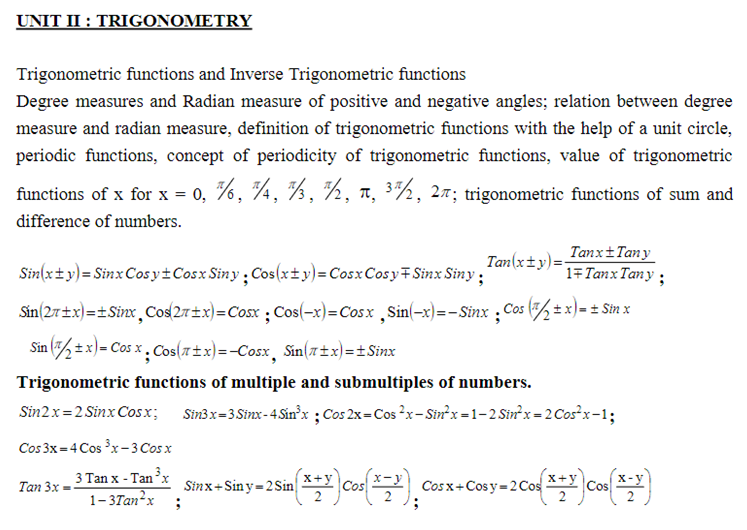
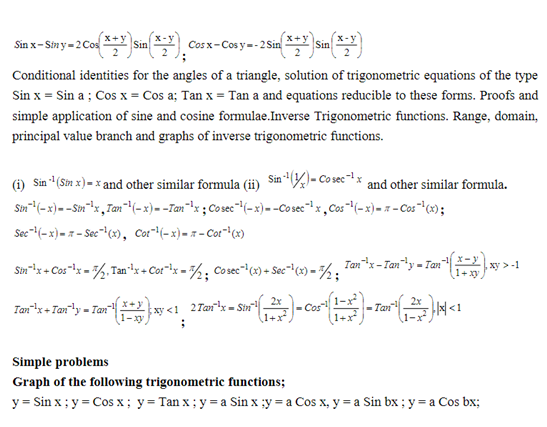
UNIT III: GEOMETRY
Lines
Cartesian system of coordinates in a plane, shifting of origin. Distance formula, Slope of line, parallel and perpendicular lines. Various forms of equations of a line parallel to axes, slopeintercept form, The Slope point form, Intercept form, Normal form, General form, Intersection of lines. Equation of bisectors of angle between two lines, Angles between two lines, condition for concurrency of three lines, Distance of a point from a line.
Conic sections
Sections of a cone. Circles, standard form of the equation of a circle, its radius and centre. Equations of conic sections [Parabola, Ellipse and Hyperbola] in standard form and simple properties.
Vectors
Vectors and scalars, Magnitude and Direction of a vector, Types of vectors (Equal vectors, unit vector, Zero vector). Position vector of a point, Localized and free vectors, parallel and collinear vectors, Negative of a vector, components of a vector, Addition of vectors, multiplication of a vector by a scalar, position vector of point dividing a line segment in a given ratio, Application of vectors in geometry. Scalar product of two vectors, projection of a vector on a line, vector product of two vectors.
Three-Dimensional Geometry
Coordinate axes and coordinate planes in three dimensional space, coordinate of a point in space, distance between two points, section formula, direction cosines, and direction ratios of a line joining two points, projection of the join of two points on a given line, Angle between two lines whose direction ratios are given, Cartesian and vector equation of a line through (i) a point and parallel to a given vector (ii) through two points, Collinearity of three points, coplanar and skew lines, Shortest distance between two lines, Condition for the intersection of two lines, Cartesian and vector equation of a plane (i) When the normal vector and the distance of the plane from the origin is given (ii) passing through a point and perpendicular to a given vector (iii) Passing through a point and parallel to two given lines through the intersection of two other planes (iv) containing two lines (v) passing through three points, Angle between (i) two lines (ii) two planes (iii) a line and a plane, Condition of coplanarity of two lines in vector and Cartesian form, length of perpendicular of a point from a plane by both vector and Cartesian methods.
Unit IV: STATISTICS
Statistics and probability
Mean deviation, variance, standard deviation for grouped an ungrouped data. Analysis of frequency distributions with equal means but different variances. Random experiments and sample space, Events as subset of a sample space, occurrence of an event, sure and impossible events, Exhaustive events, Algebra of events, Meaning of equality likely outcomes, mutually exclusive events. Probability of an event; Theorems on probability; Addition rule, Multiplication rule, Independent experiments and events. Finding P (A or B), P (A and B), Bayes' theorem,
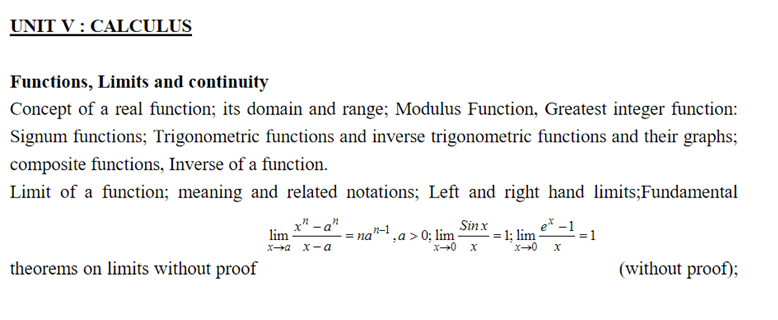

Differentiation
Derivative of a function; its geometrical and physical significance; Relationship between continuity and differentiability; Derivatives of polynomial, basic trigonometric, exponential, logarithmic and inverse trigonometric functions from first principles; derivatives of sum, difference, product and quotient of functions; derivatives of polynomial, trigonometric, exponential, logarithmic, inverse trigonometric and implicit functions; Logarithmic differentiation; derivatives of functions expressed in parametric form; chain rule and differentiation by substitution; Derivatives of Second order.
Application of Derivatives
Rate of change of quantities; Tangents and Normals; increasing and decreasing functions and sign of the derivatives; maxima and minima; Greatest and least values;
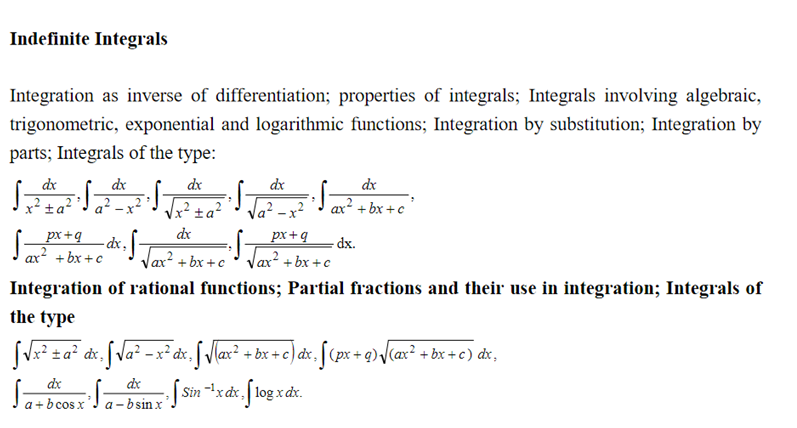

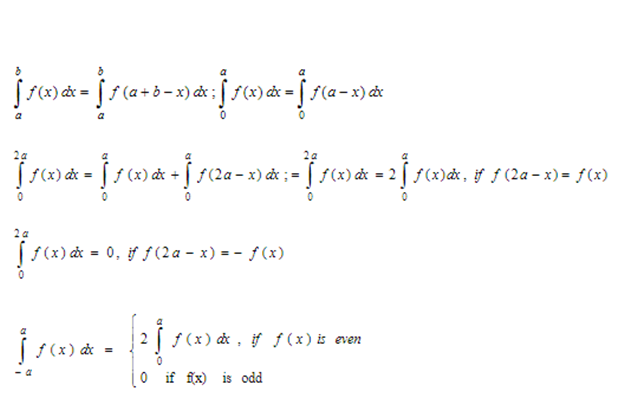
Application of definite integrals in finding areas bounded by a curve, circle, parabola and ellipse in standard form between two ordinates and x-axis; Area between two curves, line and circle; line and parabola: line and ellipse.
Differential Equations
Definition; order and degree; general and particular solutions of a differential equation; formation of differential equations whose general solution is given; solution of differential equations by method of Separation of variables; Homogeneous differential equations of first order and their solutions; Solution of linear differential equations of the type x) dx d where P (x), Q (x) are functions of x or constants.
Linear Programming
Introduction, related terminology such as constraints, 0bjective function, optimisation, different types of linear programming problems, mathematical formulation of Linear Programming Problems, graphical method of solution for problems in two variables, feasible and infeasible regions, feasible and infeasible solutions, optimal feasible solutions ( up to three non-trivial constraints).
KEAM Exam Syllabus 2025: FAQs
- What is KEAM?
- KEAM stands for Kerala Engineering Architecture Medical Entrance Examination. It is conducted by the Commissioner of Entrance Examinations (CEE), Kerala, for admission to various professional degree courses such as Engineering, Architecture, Medical, Agriculture, Forestry, Veterinary, Fisheries, etc., offered by colleges in Kerala.
- What is the syllabus for KEAM?
- The syllabus for KEAM typically covers topics from Physics, Chemistry, and Mathematics for engineering courses, and additional topics in Biology for medical courses. The syllabus is based on the Higher Secondary level (10+2) curriculum of Kerala State Board or equivalent.
- Where can I find the detailed syllabus for KEAM?
- The detailed syllabus for KEAM is provided by the Commissioner of Entrance Examinations (CEE), Kerala. It is available on the official website of CEE Kerala, as well as in the official information brochure for the exam.
- Is the KEAM syllabus different for Engineering and Medical courses?
- Yes, the syllabus differs slightly depending on the course you are applying for. Engineering aspirants need to focus on Physics, Chemistry, and Mathematics, while Medical aspirants need to study Physics, Chemistry, Biology (Botany and Zoology), along with Mathematics, if they have opted for it.
- How should I prepare for KEAM?
- To prepare for KEAM, candidates should thoroughly study the prescribed syllabus, practice previous years' question papers, and take mock tests. It's also important to focus on conceptual understanding rather than rote learning.
- Is NCERT sufficient for KEAM preparation?
- NCERT textbooks are considered the foundation for KEAM preparation, especially for subjects like Physics, Chemistry, and Biology. However, it's recommended to supplement NCERT with other reference books and study materials for thorough preparation.
- Are there any changes in the KEAM syllabus every year?
- The core syllabus for KEAM usually remains consistent, but minor changes or additions may occur occasionally. It's essential for aspirants to stay updated with any notifications or circulars released by the conducting authority regarding syllabus changes.
- Is there any negative marking in the KEAM exam?
- Yes, there is negative marking in the KEAM exam. One mark is deducted for each incorrect answer in the Physics, Chemistry, and Mathematics papers, while for medical courses, one mark is deducted for each incorrect answer in the Biology papers.
- Can I use a calculator during the KEAM exam?
- No, the use of calculators is not permitted during the KEAM exam. Candidates are expected to perform all calculations manually.
- What are the best books for KEAM preparation?
- There are various books available in the market for KEAM preparation. Some popular ones include NCERT textbooks, previous years' question papers, and reference books by renowned publishers like Arihant, Pearson, and MTG. It's advisable to choose books that cover the entire syllabus comprehensively and include ample practice questions.
Try EaseToLearn for free
Sign up for free Online Test
